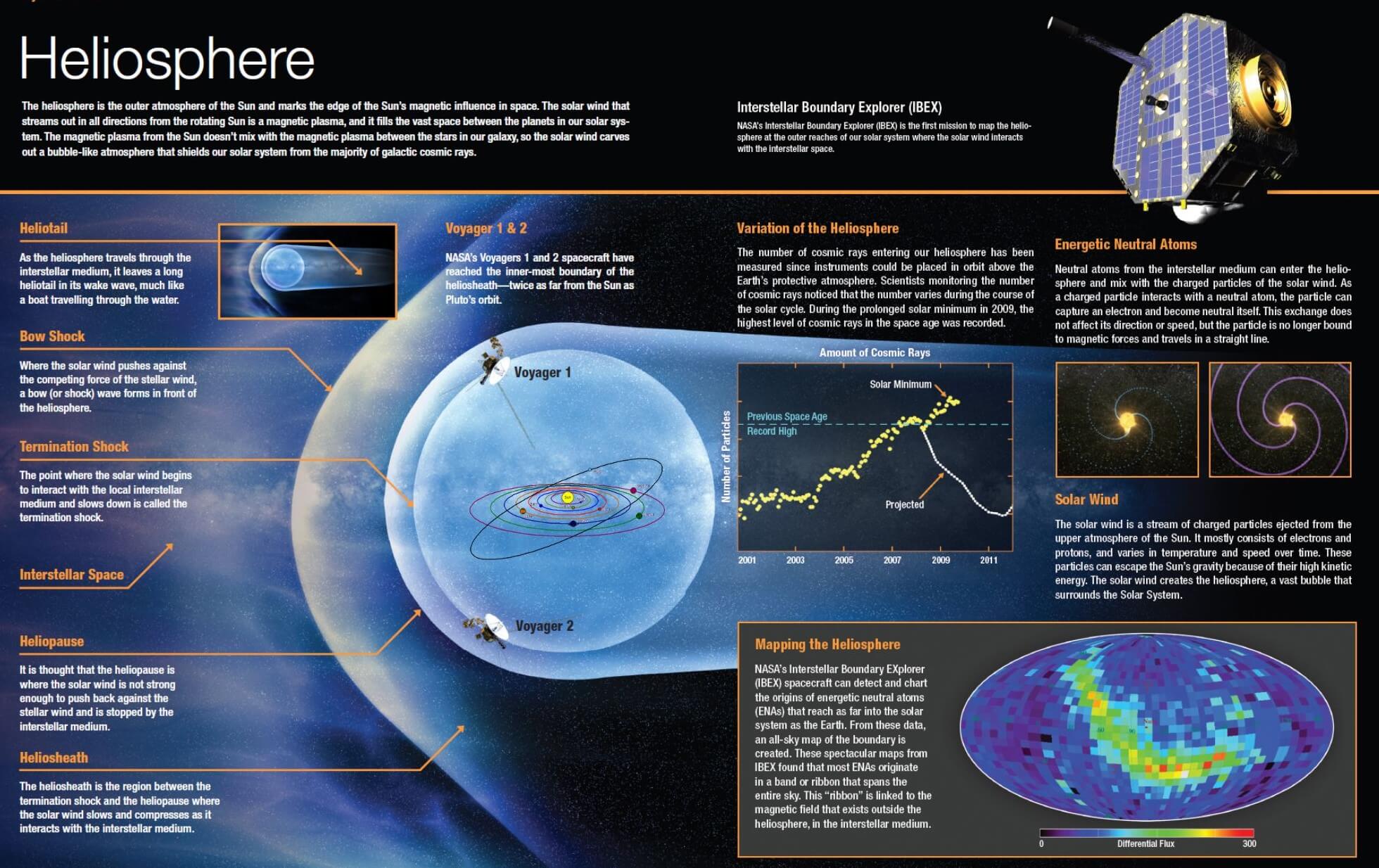Table of Contents
5. Sun and the Solar System
Our galaxy, the Milky Way, has a few hundred billion stars and almost every star has a complex planetary system around it. The planetary system of the sun is called the solar system. The sun (located around 26,000 light years from the center of the Milky Way) dominates the solar system, it is responsible for more than 99% of the total mass of the solar system. You can explore the solar system using this website.
In the solar system we have found 8 planets, almost 300 moons, more than 1 million asteroids and small bodies, and almost 4000 comets.
1. The sun
The sun, a typical star in our Galaxy, is nothing but a gigantic spherical ball of hydrogen gas with a diameter of 1.4 million km. Three fourth of the sun is hydrogen, one fourth is mostly helium with a little bit of other heavier elements. We can understand the structure of the surface and interior of the sun by analyzing sunlight and we see the corona surrounding the sun during total solar eclipses.

Going from the center to the surface, the sun has different spherical layers: (1) the core, (2) the radiative zone where heat is transferred via radiation toward the surface, (3) the convection zone where gas goes up and down in loops through convection (as in a pot of boiling water), (4) the surface called the photosphere, and (5) the atmosphere composed of the lower chromosphere and the upper corona. From earth, we normally see the photosphere of the sun and it has a temperature of around 6000 degrees. The black sunspots are seen on this surface as well.

The temperature and density of the sun increases toward the core as shown above. The left side of the figure shows how density varies from the surface (left) to the center (middle) and the right side of the figure shows how the temperature varies from the surface (right) to the center (middle). In both cases you can see that the curve rises toward the center showing increase of the quantity toward the center.
Density at the center is almost 160 grams per cubic centimeter (cc), which is much higher than the density of even iron which has a density of only 8 grams per cc; just imagine! On the other hand the density on the surface is much lower than the density of water which is only 1 gram per cc. Temperature at the center is a whopping 15 million degrees; do not forget that water boils at only 100 degrees Celsius.
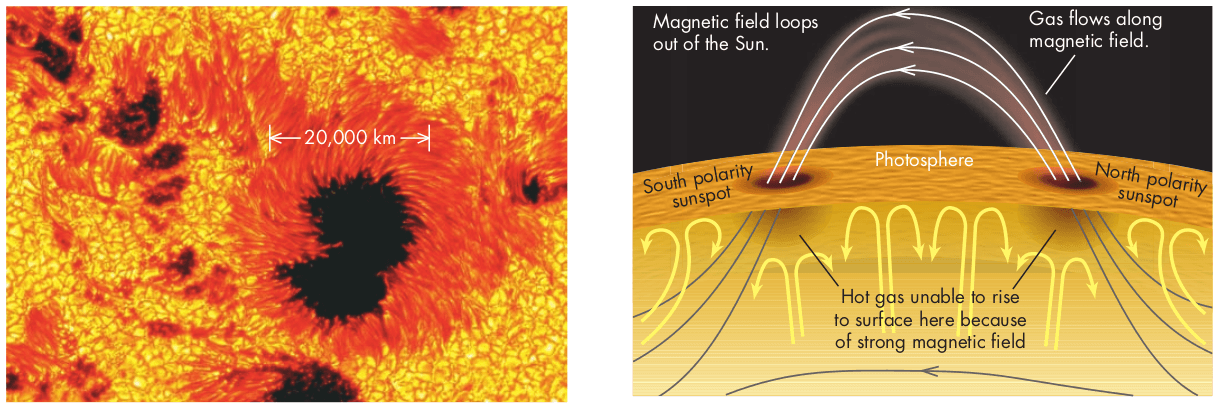
The sun has spots, hot regions on the photosphere where gas cannot rise from the interior to the surface. One of these spots can be as big as 20,000 km, bigger than the diameter of the Earth which is only 12,000 km. The right panel above explians the origin of sunspots. Magnetic field lines are going from one spot to another and the gas in the convective zone of the sun cannot rise up to the surface where there is a spot. Instead, gas flows through the invisible magnetic field lines.
The number of sunspots vary with a 11-year cycle. Every 11 years or so the number of sunspots peak and then gradually decrease to a minimum before increasing to a maximum after another 11 years. The average temperature on Earth is higher when there are more sunspots, and vice versa.
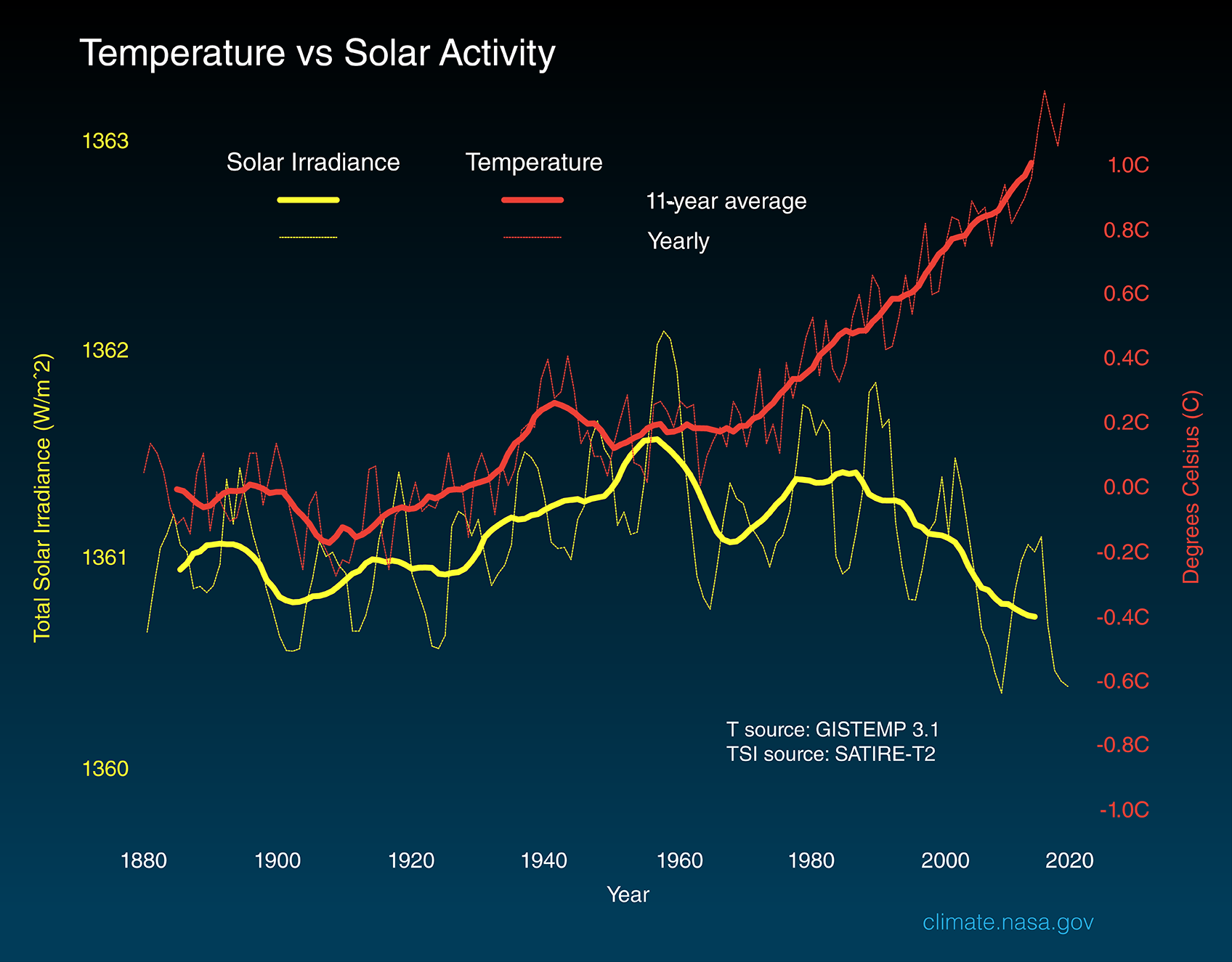
This diagram shows the ‘solar irradiance’ (amount of solar energy that reaches the earth) and the average temperature on earth over time from 1880 to 2020. The solar energy is using the yellow lines and the temperature through the red lines. The thin lines show the actual 11-year variations, and the thick lines show the overall trend in the last 150 years or so. The change is solar energy reaching earth is directly related to the number of sunspots on the surface of the sun.
You can clearly see in the above figure that the temperature and the solar energy were in sync with one another almost until the 1950s and then the temperature kept increasing without any relation to the solar energy. The temperature is shown on the right and you can see that the overall global temperature has increased by almost 1 degrees since the 1950s due to rapid growth of population and industries around the developed world.
Now you know the intimate connection of the earth and the sun, but the sun affects the whole solar system, not just the earth. Even the orbit of the dwarf planet Pluto is very small compared to the size of the heliosphere, the region around the sun affected by solar wind: energetic particles streaming out of the sun continuously.
In this infographic, you see the boundaries of the heliosphere and its size. NASA sent two spacecrafts Voyager 1 and Voyager 2 in the 1970s to explore the solar system and they both crossed all the planets and reached the termination shock of the heliosphere, a boundary where the outgoing solar wind begins encountering the interstellar medium and slows down. Orbits of all the planets fit within the central region of the bubble created by the termination shock. The sun is moving toward left in this diagram and, hence, you see that the heliopause has a tail in the direction opposite to the motion of the sun. The solar wind becomes weaker than the wind coming from other surrounding stars at the heliopause. Because of the interaction of the solar wind with the winds from other stars, a shock wave is created at the leading edge of the heliosphere called the bow shock.
Solar scientists have been able to detect the boundaries and map out the zone of influence of the sun using telescopic detectors. One such telescope is shown here: IBEX, the Interstellar Boundary Explorer.
2. The solar system
Our solar system is flat, all the planets, asteroids, comets and small bodies orbit around the sun on the same plane, as forming a loose disk. You can visualize the disk from here.
All objects orbit the sun in the same direction as well. This extraordinary sync of the orbits of almost all objects in the solar system might seem miraculous at first. But this is not surprising if you follow the figure below.
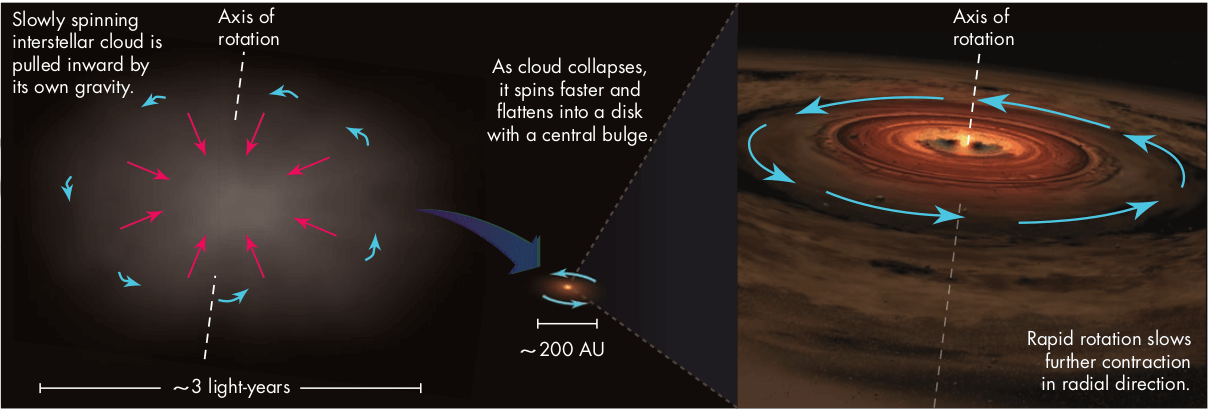
The sun and everything in its surroundings were created from a single rotating gas cloud. As the cloud condensed, the center became the sun and the surrounding became gradually flat because of the rotation. The direction of rotation of everything created out of that cloud is the same as the original direction of rotation of the cloud itself. The initial size of the cloud was almost 2 light-years, but it condensed down to only around 200 AU (astronomical unit, the distance from the sun to the earth, 150 million km).
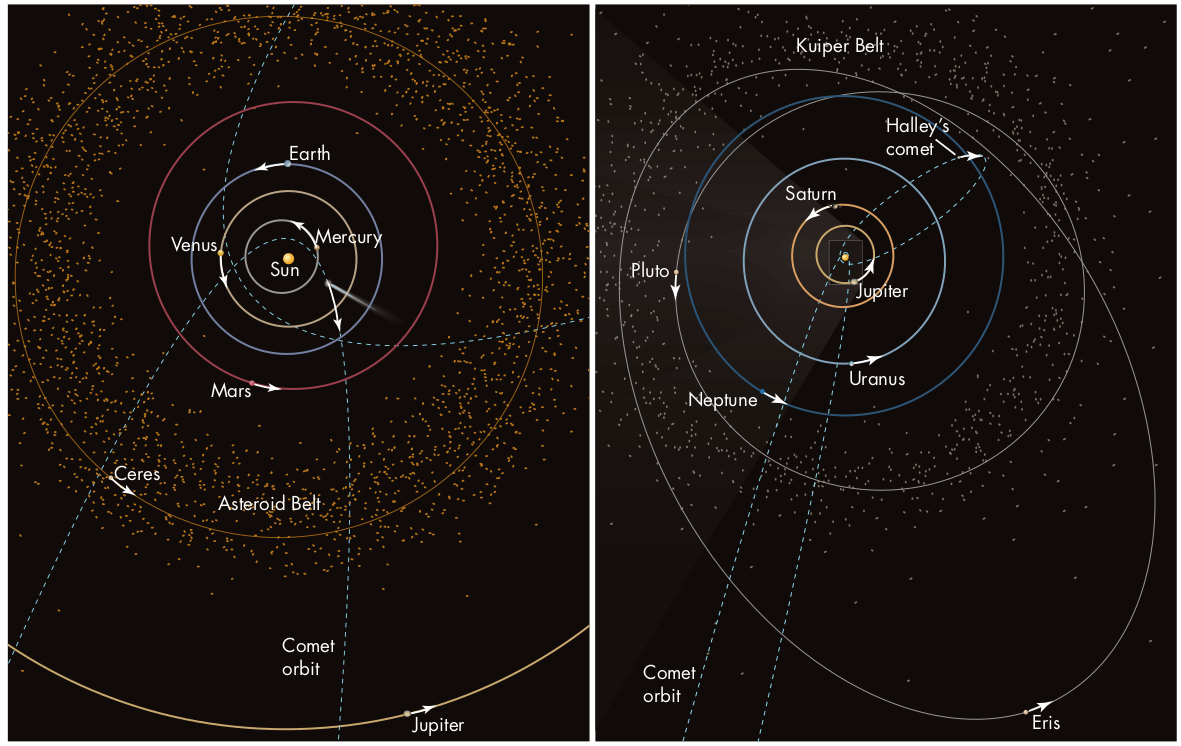
This diagram shows the solar system from above. If you could go above the disk of the solar system and look down, you would see something like this. The left panel shows the sun and the inner rocky planets (Mercury, Venus, Earth, Mars) surrounded by the asteroid belt, a belt containing more than a million kilometer-sized rocks called asteroids. The right panel shows the outer gaseous planets mostly made of gas, not rocks (Jupiter, Saturn, Uranus, Neptune). Surrounding the orbit of the dwarf planet Pluto, there is another belt of icy objects called the Kuiper belt.
Why are the planets made out of rocks and the outer planets gas and ice? Why is the asteroid belt composed of rocks and the Kuiper belt ice? It has a lot to do with temperature. Temperature decreases as you go away from the sun.
3. The earth
We talk about this planet in detail because we know most about it and also because it is our home. The inner and outer composition of the earth will tell us a lot of things about planets in general.

The earth also became an astronomical object in the 1960s when the Apollo missions took pictures of the earth from the moon and the earth became another object in the sky for us. The first picture of the earth rising above the moon is shown above. It was taken by Apollo 8 astronauts in 1968.

The interior of the earth is as complex as that of the sun. It has a ‘solid’ inner core, a liquid outer core, a mantle and a crust. The upper part of the mantle is almost like a liquid and the solid crust shakes and moves on top of this liquid-like upper mantle. The inner core is made of solid iron, the outer core of liquid iron. Because of the motion of iron at the cores, a giant magnetic field is created that extends beyond the atmosphere of the earth and creates a magnetosphere as shown below.

The magnetosphere of earth is shown by magnetic field lines coming out of the poles. This is somewhat similar to the heliosphere shown above. The magnetosphere creates similar tails and shocks as earth moves around the sun. It protects us from the harmful particles in the solar wind. Life could not exist on earth without the protection of these magnanimous magnetic fields.
I have already said that the solid crust moves on a liquid-like part of the upper mantle. This crust, that is the rocky surface of the earth, is not one solid mass, but fragmented into many tectonic plates, each plate has it own motion. The plates move at the speed of the growth of our fingernails and collide with each other. The figure above shows the most prominent plates. High mountains are created when two plates collide and deep valleys are created when they move away from each other. You can clearly see the deep valley underneath the Atlantic ocean in google maps. This ridge, deep ridge, is created because the American plates are moving away from the African and Eurasian plates. The movement of the plates keeps the surface of the earth active.
4. The planets
There are 8 planets in the solar system and a few dwarf planets like Pluto and Ceres.

Like the earth, all planets and dwarf planets revolve around the sun and rotate on their own axis. Here you see the tilt of the axis of rotation for the planets. Earth’s axis is tilted by 23.5 degrees from the vertical, Mercury has no tilt. Venus is completely flipped, it rotates upside down. Uranus rotates with respect to an axis that lies on the plane of the solar system, it rotates lying down, weird!
4.1 Terrestrial planets
Mercury, Venus and Mars are called terrestrial planets because they are similar to the earth (‘terra’), they are made of rocks mostly. You can call them rocky planets as well. They are characterized by a dense rocky sphere surrounded by a thin gaseous atmosphere.

As you can see, all the terrestrial planets, and even the moon, have a inner core made solid iron and nickel. Outside the core, they have rocks made of silicates. The moon is almost like a failed terrestrial planet, it is not that small compared to Mercury.

The Moon and the Mercury do not have atmospheres, but the Earth, Mars and Venus do. The atmospheres of Mars and Venus are dominated by $CO_2$ (carbon-di-oxide), but the atmosphere of Earth is rich in nitrogen ($N_2$) and oxygen ($O_2$). The clouds of Earth are made of frozen water, the clouds of Mars are made of CO$_2$, but the clouds of Venus are made of poisonous sulfuric acid. The surface of Venus is flooded with acid rain.
Mercury is the closest to the sun, but Venus has the highest atsmospheric temperature (500 $^\circ$C) because of excessive greenhouse effect in its atmosphere. Average temperature on the surface of the earth is 287 kelvin or 14 degrees Celsius, and it keeps decreasing as you go toward Mars.
4.2 Giant planets
The four outer planets, the planets outside the asteroid belt, are called giant planets because they are big. Among them, Jupiter and Saturn are called ‘gas giants’ because they are mostly made of gas, and Uranus and Neptune are called ‘ice giants’ because they have a lot of icy material.
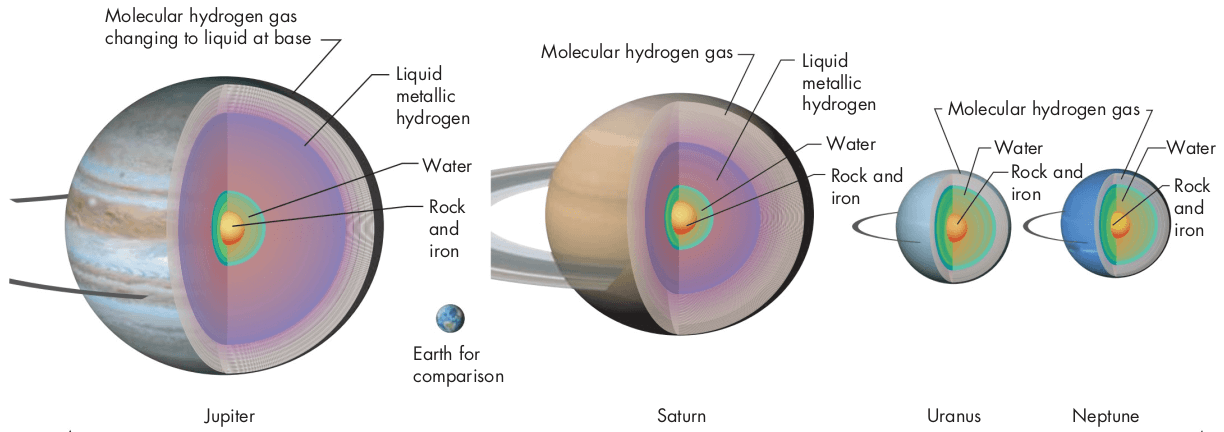
Here you see the composition of the giant planets. All of them have a very small solid core made of rock and iron surrounded by a layer of water. Jupiter and Saturn have layers of liquid metallic hydrogen outside the water layer, and then a layer of gaseous hydrogen as the surface. Uranus and Neptune do not have the liquid metallic hydrogen layer, but only a gaseous hydrogen layer.
One very interesting fact is that the earth is smaller than the cores of these planets. Each of the giant planets harbor a solid sphere the size of the earth at their center.
:img:planets
4.3 The moons
Only Earth and Mars among the terrestrial planets have moons, or natural satellites. Our moon is the ‘moon’, but the natural satellites of other planets are sometimes also called ‘a moon’. Almost 300 moons have been discovered. Any object orbiting a planet is a moon no matter how small. But only 19 of the almost 300 moons are big enough to be completely round in shape because of their self-gravity.

The major round moons of the solar system are shown above. The moons of Mars are not really visible at this scale because they are too small and not big enough to be round. A planet like the earth normally does not have as big a satellite as the moon, it seems like an exceptional case. As you can see, the moons of the giant planets are almost comparable to the moon in size. The four moons of Jupiter shown here were discovered by Galileo.
5. Small bodies
There are a lot of bodies in the smaller system smaller than planets and their satellites. We will talk about mainly asteroids and comets.

Most asteroids are located in a ring between the orbits of Mars and Jupiter as you see above. Each dot here is an asteroid with a size bigger than 1 km. There are asteroids as big as 10 km. A 10-km asteroids hit the earth 65 million years ago and caused massive extinction of life.
There are some asteroids, the greeks and the trojans, in the orbit of Jupiter and they revolve around the sun together with Jupiter.

Surrounding all the planets there is another belt of icy objects called the Kuiper belt. Note that the distance of the Kuiper belt is 50 AU, that is 50 times the distance from the sun to the earth. But it turns out even Kuiper belt is nothing compared to the huge Oort cloud that surrounds the whole solar system and reach interstellar space. The Oort cloud is a giant sphere of icy objects at extremely low temperature. The cloud has a radius of 100,000 AU.
Try to fathom this. The Kuiper belt is more distant than the farthest planet from the sun, and the distance of the Kuiper belt from the sun is only 50 AU. On the other hand the outer edge of the Oort cloud is 100,000 AU from the sun.
Comets live in the Oort cloud as boring icy rocks. But when they enter the solar system, their ice melts and creates a huge tail and we call them comets because of the tail.
Many of the figures have been taken from Explorations by Thomas Arny & Stephen Schneider.
